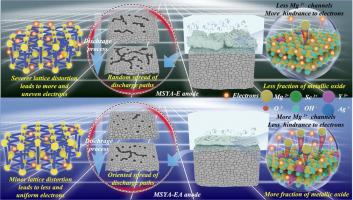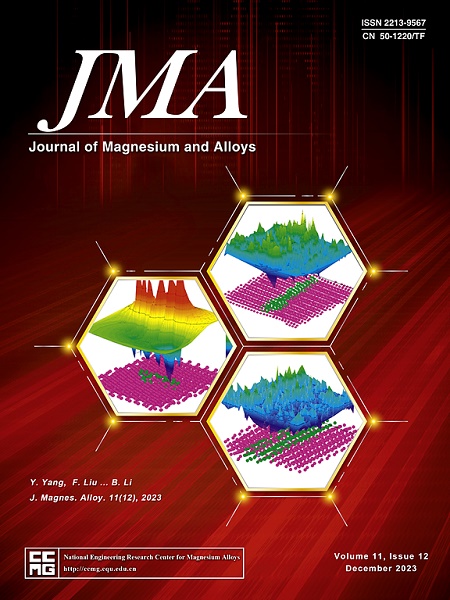Revealing the intrinsic connection between residual strain distribution and dissolution mode in Mg-Sc-Y-Ag anode for Mg-air battery
IF 15.8
1区 材料科学
Q1 METALLURGY & METALLURGICAL ENGINEERING
引用次数: 0
Abstract
The dominated contradiction in optimizing the performance of magnesium-air battery anode lies in the difficulty of achieving a good balance between activation and passivation during discharge process. To further reconcile this contradiction, two Mg-0.1Sc-0.1Y-0.1Ag anodes with different residual strain distribution through extrusion with/without annealing are fabricated. The results indicate that annealing can significantly lessen the “pseudo-anode” regions, thereby changing the dissolution mode of the matrix and achieving an effective dissolution during discharge. Additionally, p-type semiconductor characteristic of discharge product film could suppress the self-corrosion reaction without reducing the polarization of anode. The magnesium-air battery utilizing annealed Mg-0.1Sc-0.1Y-0.1Ag as anode achieves a synergistic improvement in specific capacity (1388.89 mA h g-1) and energy density (1960.42 mW h g-1). This anode modification method accelerates the advancement of high efficiency and long lifespan magnesium-air batteries, offering renewable and cost-effective energy solutions for electronics and emergency equipment.


揭示了镁空气电池Mg-Sc-Y-Ag阳极残余应变分布与溶解方式之间的内在联系
镁空气电池负极性能优化的主要矛盾在于放电过程中活化与钝化难以达到良好的平衡。为了进一步调和这一矛盾,通过挤压退火和不退火制备了两个残余应变分布不同的Mg-0.1Sc-0.1Y-0.1Ag阳极。结果表明,退火可以显著减少“伪阳极”区域,从而改变基体的溶解模式,在放电过程中实现有效的溶解。此外,放电产物膜的p型半导体特性在不降低阳极极化的情况下抑制了自腐蚀反应。采用退火Mg-0.1Sc-0.1Y-0.1Ag作为阳极的镁-空气电池,在比容量(1388.89 mA h g-1)和能量密度(1960.42 mW h g-1)方面实现了协同提升。这种阳极改性方法加速了高效、长寿命镁空气电池的发展,为电子和应急设备提供了可再生的、具有成本效益的能源解决方案。
本文章由计算机程序翻译,如有差异,请以英文原文为准。
求助全文
约1分钟内获得全文
求助全文
来源期刊

Journal of Magnesium and Alloys
Engineering-Mechanics of Materials
CiteScore
20.20
自引率
14.80%
发文量
52
审稿时长
59 days
期刊介绍:
The Journal of Magnesium and Alloys serves as a global platform for both theoretical and experimental studies in magnesium science and engineering. It welcomes submissions investigating various scientific and engineering factors impacting the metallurgy, processing, microstructure, properties, and applications of magnesium and alloys. The journal covers all aspects of magnesium and alloy research, including raw materials, alloy casting, extrusion and deformation, corrosion and surface treatment, joining and machining, simulation and modeling, microstructure evolution and mechanical properties, new alloy development, magnesium-based composites, bio-materials and energy materials, applications, and recycling.
 求助内容:
求助内容: 应助结果提醒方式:
应助结果提醒方式:


